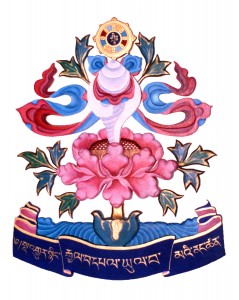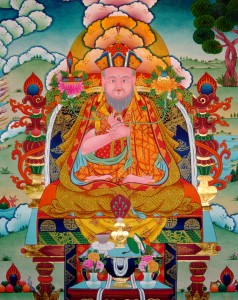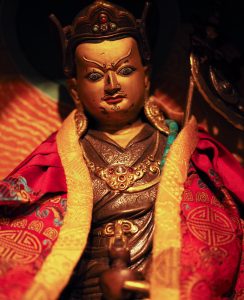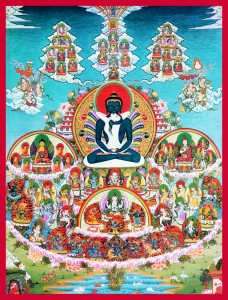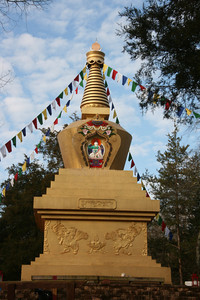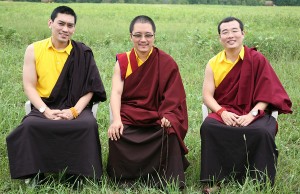
“The following is an excerpt from a teaching offered by Tulku Dawa Gyalpo at Kunzang Palyul Choling in Maryland. Future posts will continue with the teaching on the Life of Migyur Dorje.
Now I think it’s time to tell why he passed away so fast. Karma Chagmed explains one reason very clearly in Tulku Migyur Dorje’s life story. He said that it is very obvious. I think there is also one other reason that is not so obvious, but it isn’t described as another reason. One reason he gave I also heard very clearly from our late Holiness. There is a pure realm called Metok Tram [Tram means distributed all over], Metok Trampa. Metok Dronpi. Karma Chagme wrote that in the Buddha field of Metok Tram, which literally means June flower, the Buddha Metok passed away. They needed somebody to take care of that pure land. They said that Tulku Migyur Dorje had to go there and take his place. Tulku Migyur Dorje didn’t want to go there, but he had no choice. He had to go there. That’s why he changed his life. This reason is very clear. His Holiness also mentioned it.
This, I think, is another reason. In our refuge field there are the five Gonpos. One of them is Gonpo Ma-Ning. During his second retreat, Tulku Migyur Dorje revealed a treasure to Karma Chagme in which he experienced that Gonpo Ma-Ning was kind of eating Tulku Migyur Dorje’s body. Through that sound, he received one of the sadhanas of Gonpo Ma-Ning. Tulku Migyur Dorje asked Karma Chagme, “Do you want to write this down?” Karma Chagme replied to him, “No!” He was kind of scared. He said, “Alas. I don’t want to write the sadhana which comes from eating your body!” And he didn’t write that. Tulku Migyur Dorje said, “OK. If you don’t write it down, then I have to give it back.” Tulku Migyur Dorje said, “Take it back.” And they did. During that night, Tulku Migyur Dorje was a little bit upset and he looked at Karma Chagme and he said, “This is how these samsaric people act. They get unnecessarily scared.” He said also, “This is the sadhana that will get rid of my big obstacles, but you don’t want to write this.” In his story, it is not mentioned clearly that this is one reason, but I think that it is.
However, the first reason which I gave you is obvious. His life changed like that when he was very young. Later, Karma Chagme started investigating what would happen next: where Tulku Migyur Dorje was going to be. Maybe some of you heard that he went down to the hell realm and liberated many beings from there. After sometime, he got tired because there are so many living beings there. He took some fine sand. After reciting a lot of mantra, he blew on the sand and threw it in those fires. By just throwing the sand, it cleaned all those fires. Still in the intermediate state time, he was there for others.
Karma Chagme wanted to know where Tulku Migyur Dorje was going. In his own experience, he heard very clearly that Tulku Migyur Dorje would take another 21 lives. Within those 21 lives, during two of them he would not do anything, would not benefit others, would not reveal treasures. It seems like he would be resting. That’s what Karma Chagme heard. During the other 19, he would complete whatever treasures were not revealed.
That’s the life of Tulku Migyur Dorje. Right now we have the same profound, precious teaching; and right now we have great masters like Holiness Karma Kuchen that we can rejoice in, and likewise so many other great masters. Mugsang Kuchen Rinpoche is also considered his reincarnation. We Palyul have great masters like Tulku Thubsang and Gyangkhang Rinpoche, all three heart sons as we know. Not only do we have them, we have so many others as well. All of them keep this profound teaching, unconditionally, but not with blind faith. We are trying to keeping this with wisdom. Understanding like this.
Now I think I have completed. Thank you so much once again to everybody for giving me this opportunity to talk about it. And also to Jetsunma Akhon Lhamo. I enjoyed it so much. Yes, I will stop here.
Dedication now.
Today we are specially related with this topic, so I want you to dedicate and make an aspiration. After dedication, making an aspiration is important. Dedication is just giving up. You are just letting go of whatever merit you accumulated from 7:30 to now. You are just offering. Offering is kind of like giving up. Let it go. From there, it’s not yours. Right? Once you offer it means tit does not belong to you. You already offered it. After we offer, then we have to make aspirations. “Through this merit then may I get” that-that-that whatsoever. So specially today I want all of us to make aspiration. After understanding this history, may I have confidence in it and put into practice the generation and completion stages. May I also achieve the same as Tulku Migyur Dorje. Make that aspiration. And after that, make aspiration for whatever circumstances you would like. “May I be healthy. May I get a good job. “May I get” whatsoever. Yes, I’m serious. You can make these aspirations. They work. If you look in history, they made aspiration that way; they achieved that way.
Sometimes we don’t know how to make aspirations. That spoils our merit. We make aspirations for the first purpose, which is to become enlightened. But we also need circumstances. So this is the second purpose for aspiration. So please, dedicate and make aspirations together.
